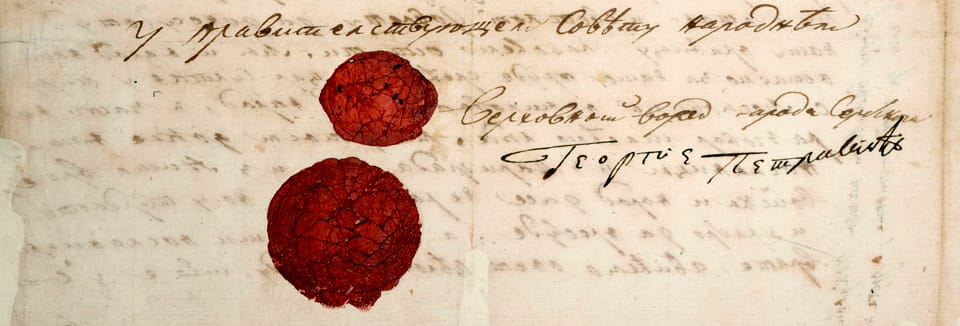
SASA Archives
The SASA Archives collects and stores archival records significant to the history of the Serbian Academy of Sciences and Arts, its predecessors and the entire Serbian people. The Archives engages in the protection, conservation and restoration of records, their organization, processing and publishing. It also has an important role in helping scholars, students and other researchers use sources from the SASA Archives records. The cooperation with similar institutions from Serbia and from abroad has particular relevance.
The Archives of the Serbian Academy of Sciences and Arts in Belgrade was founded in 1841, at the same time as the Society of Serbian Letters (SSL), the highest institution of sciences and arts in the Principality of Serbia. Since the very beginning, the Society collected Serbian history sources – books, documents, letters, artworks and everyday objects, and in this noble work, it received help from all regions occupied by Serbian people. Starting in 1864, the Serbian Learned Society (SLS) succeeded the SSL and continued its work, as well as its compilation of historical treasures. When the SLS grew into the Serbian Royal Academy (SRA) in 1886, the Archives became its part. There were 263 old manuscripts and printed books within the Old Collection and 1,397 documents in the Historical Collection.
Having been moved from 15 Brankova Street to 35 Kneza Mihaila Street in 1952, the Archives of the Serbian Academy of Sciences and Arts (SASA Archives) was provided with its own space: a records depot, a reading room and an office, and professional supervision issued, headed by a director and archivists. Several years later, the reading room of the Archives was equipped with card catalogues, a microfilm reader and a reference library.
There are five collections in the possession of the SASA Archives: the Old Collection, the Historical Collection, the Oriental Collection and the Decoration Collection.
The Archives holds the records of the Society of Serbian Letters (1841–1864), the Society of Learned Society (1864–1892), the Serbian Royal Academy (1887–1944) and two abolished institutes of the Serbian Academy of Sciences – the Institute for Literary Studies (1947–1954) and the Institute for Rural Studies (1948–1954). The SASA Archives stores the minutes of the SASA Executive Board sessions, and minutes of the sessions of the Executive Board of the SASA Presidency, as well as minutes of regular, extraordinary, ceremonial and electoral sessions of the assemblies of the Serbian Academy of Sciences and Arts, and files on the deceased members of the Serbian Academy of Sciences and Arts.
Since 2002, the Archives of the Historical Institute has also become a part of the SASA Archives. It consists of the legacies of Jovan Ristić, Matija Ban, Vladimir Ljotić, Konstantin Nikolajević, Paja Mihajlović, Janko Šafarik, Svetozar Popadić, the correspondence of Milan Đ. Milićević, Čedomir Mijatović and a unit titled ‘The First World War’, which mostly contains foreign newspaper clippings on Serbia.
Based within the SASA Archives, there is the Cabinet for Dubrovnik Studies, which was formed from the documents of Academician Miroslav Pantić, who compiled them while researching the State Archives in Dubrovnik. It consists of copies of archival materials, letters, newspaper clippings, photographs, microfilms, books, and literature on Dubrovnik studies from the Middle Ages to the present day.
The Old Collection, following the National Library’s demise in 1941, became the largest collection of old Serbian manuscripts and printed books in Serbia, collected in the period from the 13th to the 19th centuries. Among others, it contains Dečanska hrisovulja (Dečani Chrysobull no. 360), Žitija kraljeva i arhieskopa srpskih (The Lives of the Serbian Kings and Archbishops) by Archbishop Danilo II, Služabnik (Breviary) (from 1554), Zakon o rudnicima (the Mining Code) of Despot Stefan Lazarević no. 465), Gorički zbornik (Gorica Manuscript) (no. 446), Kumaničko četvorojevanđelje (Kumanica Tetraevangelion, No. 69), a manuscript copy of Banjska povelja (Charter to Banjska Monastery, No. 495), Aleksandrida (The Greek Alexander Romance), the tales on Kosovo battle from the legacy of Jovan Tomić, as well as numerous church miscellanies, oktoeches, menaia, psalters, euchologia, as well as some of the works by Jovan Rajić, Vićentije Rakić, Dositej Obradović, Pavle Solarić, Lukijan Mušicki, Joakim Vujić, and Sima Milutinović Sarajlija.
The Oriental Collection contains manuscripts and printed books, documents, berâts (documents of privileges granted by a sultan) and firmans, discussions on various principles in Islam, dictionaries, collections of poems, folk medical books, calendars, A History of Turkey (1166-1188). It was written in Turkish, Persian and Arabic, in the period from the 15th – 20th centuries.
The Historical Collection includes records from medieval to present times, consisting of medieval charters either in original or copied form, documents, correspondences, protocols, manuscripts, foreign archives documents, memoirs, compositions, photo albums, etc. The legacies of Serbian ruling families (the dynasties of Obrenović and Karađorđević, and Despot Đorđe Branković’s family), major figures in science, art and politics such as Vuk Karadžć, Sima Milutinović Sarajlija, Stevan Knićanin, Feliks Kanic, Jovan Ristić, Jovan Cvijić, Stevan Mokranjac, Milutin Milanković, Ivo Andrić, Branko Ćopić and many others are part of this collection.
Documents are written in Church Slavonic, Serbian, Latin, Russian, French, English, German, Italian, Hungarian, Turkish, Greek and other languages.
The Ethnographic Collection incorporates folk poems (lyric and epic), short stories, fables, proverbs, riddles, conundrums, salutes, catchphrases, counting songs, sayings, traditions, witchcraft, incantations, beliefs, divinations, words, Serbian national dishes recipes, costumes, lifestyle excerpts, customs, games, ornaments – embroideries, patterns, folk attire, folk medicine (medical books), etc. The Collection encompasses the period between the 19th and the 20th centuries.
The Decoration Collection is a unique collection of orders, medals, medallions, diplomas, charters, badges and other decorations given to the Academy, its Archives, academicians and other distinguished figures of Serbian history. Since it was established in 1997, over 1000 items have been inventoried. A part of this collection is displayed as a permanent exhibition on the first floor of the SASA Palace.
The collection is available at www.odlikovanja.sanu.ac.rs
